EAPP Quarter 2 Module 5 PDF

| Title | EAPP Quarter 2 Module 5 |
|---|---|
| Course | Hg Esd Graduate Thesis |
| Institution | Massachusetts Institute of Technology |
| Pages | 70 |
| File Size | 1.9 MB |
| File Type | |
| Total Downloads | 13 |
| Total Views | 180 |
Summary
Please use this correctly...
Description
NOT
English for Academic and Professional Purposes Quarter 2 – Module 5 WRITING REPORT SURVEY/ FIELD REPORT/LABORATORY/ SCIENTIFIC TECHNICAL REPORT
1
Department of Education ● Republic of the Philippines
2
English for Academic and Professional Purposes - Grade 12 Quarter 2 - Module 5: Writing Report Survey/Field Report/Laboratory/Scientific Technical Report First Edition, 2020 Republic Act 8293, section 176 states that: No copyright shall subsist in any work of the Government of the Philippines. However, prior approval of the government agency or office wherein the work is created shall be necessary for exploitation of such work for profit. Such agency or office may, among other things, impose as a condition the payment of royalty. Borrowed materials (i.e., songs, stories, poems, pictures, photos, brand names, trademarks, etc.) included in this book are owned by their respective copyright holders. Every effort has been exerted to locate and seek permission to use these materials from their respective copyright owners. The publisher and authors do not represent nor claim ownership over them. Published by the Department of Education – Division of Cagayan de Oro Development Team of the Module Author/s:
Estormeo G. Serena, Marylene C. Tizon, Diocesa V.Montecalvo,
Cirila C. Natividad Reviewers: Illustrator and Layout Artist: Management Team Chairperson: Cherry Mae L. Limbaco, PhD, CESO V Schools Division Superintendent Co-Chairperson:
Alicia E. Anghay, PhD, CESE Assistant Schools Division Superintendent
Members Lorebina C. Carrasco, OIC-CID Chief Ray O. Maghuyop, EPS-Math Joel D. Potane, LRMS Manager Lanie O. Signo, Librarian II Gemma Pajayon, PDO II Department of Education – Division of Cagayan de Oro City Office Address: Fr. William F. Masterson Ave Upper Balulang Cagayan de Oro Telefax: (08822)855-0048 E-mail Address: [email protected]
3
Table of Contents
How to Learn from this Module
ii
Icons of this Module
iii
What I Need to Know
iii
What I Know
iv
Lesson 1:
What I Need to Know: Should and Not Should of a Survey 1 Questionnaire What’s New: Advantage and Disadvantage
2
What is It: The Various Kinds of Reports
2
What’s More: Let’s Fill it Up
4
What I Can Do: Simulation
5
Lesson 2 Conducting a Survey What is It: The Steps in Conducting a Survey
6
What’s New: Ranking of Home Quarantine Activities
6
What I Can Do: Let’s Get Involved in the Real World
6
What’s More: Answering Questions
9
What I Have Learned: Synthesizing Learning
10 10
Lesson 3 Gathering Information from Surveys What’s New: Types of Survey Questions 4
What’s More: Crafting Survey Questions What I Have Learned: Synthesizing Learning Lesson 4 Disseminating Information From Surveys What’s more: Graph making What I have Learned: Synthesizing Learning Lesson 5 Summarizing Findings and Executing the Report through Survey What Is it What I have Learned: Synthesizing Learning What’s New: Guess the Word What’s More: Reading with Action What I have Learned: Synthesizing Learning What Can I Do: Looking For Lesson 6 Writing s Survey Report What’s New: Bite the Apple What’s More: Vocabulary Dialect What I have Learned: Synthesizing Learning What Can I Do: Happy time Together Assessment: (Post-Test) Key to Answers References
5
How to Learn from this Module To achieve the objectives cited above, you are to do the following: •
• •
Take your time reading the lessons carefully. Follow the directions and/or instructions in the activities and exercises diligently. Answer all the given tests and exercises.
Icons of this Module What I Need to Know
This are go
part contains learning objectives that set for you to learn as you along the module.
What I know
This your
meant
is an assessment as to level of knowledge to the subject matter at hand, specifically to gauge prior related knowledge
This What’s In
What’s New
part connects previous lesson with that of the current one.
An introduction of the new lesson through various activities, before it will be presented to you
What is It
These are discussions of the activities as a way to deepen your discovery and understanding of the concept.
What’s More
These are follow-up activities that are intended for you to practice further in order to master the competencies.
What I Have
Activities designed to process what you
Learned
have learned from the lesson
What I can do
These are tasks that are designed to showcase your skills and knowledge gained, and applied into real-life concerns and situations.
In this module, you will be provided with some exciting and interesting opportunities in learning. In lesson one, you will learn how to make a survey questionnaire and in lesson two, you will explore a community survey which will be very useful in your endeavor after senior high school so that you will become knowledgeable individuals. Lesson three will teach you how to gather information from surveys and how to disseminate the written forms of information from survey will be elaborated in lesson four. Challenging tasks await you in lessons five and six as you will summarize findings and execute the report survey and write a survey report respectively. The following lessons will be discussed in this module: ● ● ● ● ● ●
Lesson 1 – Designing Survey Questionnaire ▪ CS_EN11/12A-EAPP-IIe-j-7 Lesson 2 – Conducting a Survey ▪ CS_EN11/12A-EAPP-IIe-j-8; Lesson 3 – Gathering Information from Surveys ▪ CS_EN11/12A-EAPP-IIe-j-9 Lesson 4 – Disseminating written forms of information from surveys ▪ CS_EN11/12A-EAPP-IIe-j-10 Lesson 5 – Summarizing Findings and executing the report through surveys ▪ CS_EN11/12A-EAPP-IIe-j-11 Lesson 6 – Writing a Survey Report ▪ CS_EN11/12A-EAPP-IIe-j-12
After going through this module, in lesson 1 you are expected to: 1. Discuss how to make a survey questionnaire and the methods of administering the survey. 2. Make example survey questions using varied questions. 3. Come up with a questionnaire needed for their community survey. 4. Elaborate the value of being truthful and objective. After going through this module, in lesson 2 you are expected to: 1. Follow the steps in conducting a survey. 2. Create a graphic representation to present the results accurately.
3. Conduct an actual community survey to gather input from the people on a particular issue in the community. 4. Elaborate the essence of group work and collaboration. For the facilitators: 1. Introduce the lesson on designing and conducting a survey. Engage learners to do the activities religiously, and let the learners carry the tasks with ease and confidence. 2. Do the What I Know: Instruct the learners to answer the questions to test how far they know about designing and conducting a survey. 3. Do the activity What’s New: Activate the learners' understanding of the topics by letting them answer varied activities. 4. Allow students to read in What is It. Let the learners fully discover and comprehend all topics discussed in this module. 5. Let the learners answer the activities on What’s More. Check if they have understood the topics. Deepen their understanding by completing the guided questions on what I have learned section. 6. Assign the students to do What I can Do activities that shall transfer knowledge /skills gained or learned into real life situation.
General Instructions Now that you are holding this module, do the following: 1. Understand carefully the objectives and directions in each lesson. 1. Comprehend well each lesson discussed. 2. Engage actively in every activity provided. 3. Answer honestly the pretest and posttest given. 4. Experience actual survey in your community. 5. Write a survey report that will open doors for improvement.
PRE-TEST
Instructions: Consider yourself as a client to answer the questions below. On the space before each number, write T if you think the question is clear and understandable and it does not create any difficulty and confusion and F if it is confusing or difficult. _____ 1. What medium of communication you will use to become updated with the events? Magazine or Newspaper Radio Television Internet
_____ 2. What is your most usual means you use to become updated with the events? Magazine or Newspaper Radio Television Internet _____ 3. Enter in the boxes opposite the three options you selected below Option A Option B Option C Option D Option E Option F _____ 4. Below are the features of camping holiday. Indicate their importance to you by numbering from 1-4 in order where 1 is the most important. People ______ Cost ______ Open Air ______ Mobility ______ Atmosphere ______ _____ 5. “Have you been to an out of town trip recently?” _____ 6. “Have you been to an out of town trip in the last two weeks?” _____ 7. “Do you think women should eat less and exercise more?” _____ 8. “ Are you against a ban on marijuana?” _____ 9. Give your age on 1st June 2019 _______ years. _____ 10. Are you… ______ Under 18 ______ 18-65 ______ Over 65
What Is It
The Various Kinds of Reports Reports are more likely needed for business, scientific and technical subjects, and in the workplace. They are of different types and they differ in their aims and structures. TYPES 1. Survey Report
2. Laboratory or Scientific Technical Report 3. Field Report
DEFINITION/ OBJECTIVES DESCRIPTION It is written after getting To collect people’s data from a survey. responses or answers about a particular issue or topic It is commonly called lab To present results or report. It is written in a findings from experiments. formal and organized manner. It is sometimes called trip To describe and analyze a report. systematic observation.
Among these types of reports, survey is the most popularly and widely used as it is the easiest way to gather information about any topic or issue from a big number of people or groups.
It is a data gathering tool having set of questions used in a survey and is utilized in various fields such as politics, research, marketing, media and so on. It is intended to gather data, views, opinions and others from individuals or a particular group of people. It is an important method used in order to collect the necessary information that will benefit the people and the community.
Administering a survey calls for a more systematic way in order to achieve the aims of a certain survey conducted. The following methods are introduced by Sarah Mae Sincero. 1. Personal Approach This involves the person himself/ herself conducting the survey.
a. Face-to-face Structured Interview The interview is set personally and the people involved face each other in order to gather the necessary information.
Questions on the survey are asked directly to the respondent by the researcher. b. Telephone Survey The survey is done using telephone or cellular phones. The calls are made to ask individuals on particular questions. This method can be used for asking consequential questions.
2. Self- administered Approach In this type, the survey is administered by the researcher himself/herself.
a. Paper- and - pencil Survey This is a traditional method wherein the respondents who usually preferred the manual method must be present in the administration of the survey.
b. Online Survey Also called internet survey, is one of the most famous sources of data collection, where a set of survey questions is sent out to respondents and the members of this sample can respond to the questions over the internet. Respondents receive online surveys in various ways such as email, embedded over website, social media
c. Mail Survey This popular tool requires an easyadministering of the survey where survey questionnaires are mailed to individuals who are given enough time to read and ponder on the information asked.
What’s New
Directions: As you analyze the information, complete the given table with what you think of the advantages and disadvantages of each method. Method Advantages Disadvantages 1. Face-to-face Structured Interview 2. Telephone Survey 3. Paper-and-pencil Survey 4. Mail Survey 5. Online Survey
Concise and easy to understand questions lead to a successful survey. Thus, a well -designed survey questionnaire will ensure an effective data and information gathering. A survey questionnaire should be well – constructed so that the respondents could read carefully and understand thoroughly and be motivated to complete it. Therefore, a questionnaire… 1. Should use words that have clear meaning. The questions should not be vague and difficult to comprehend so that the questionnaire will not be left unanswered. 2. Should cover all possible options. The respondents should just be given at most five ranking options and should cover all so that they will not be tired of choosing a lot of options which do not give the choices they look for. If this will not be observed, this will lead to an abandoned questionnaire. 3. Should not ask two or more questions in one sentence. The question should focus on one topic or item at a time so that the respondents will not be confused which to answer and what to choose. 4. Should provide an out- option. The survey should give the respondents the option to choose “Does not apply “ or “None” for questions they do not feel answering. 5. Should consider appropriate time reference.
Respondents could not easily recall past long experiences and be doubtful as to the exact measurement or time they spent. 6. Should have a clear question structure. Survey questionnaire should follow the three parts: the question stem, additional instructions and response options so that the respondents will not be confused what to answer or choose. This will result to unreliable gathered data. 7. Should have open specific response options. The respondents should be guided on what to choose. So the survey should provide specific options to choose from so that respondents will not be confused in answering. 8. Should not have any bias or prejudice. Questions should be objective and lead to an honest answer. The respondents should not be lead to a biased option that they may fail to give their truthful response. 9. Should not include too personal or too embarrassing questions. Questions should be gender and culture sensitive so that the respondents may not feel awkward or embarrassed in giving their responses. 10. Should avoid double negative questions. Double negatives may occur when respondents are asked of their agreement on a certain issue. This should be avoided so that the respondents ‘response will be clear and precise. 11. Should outline instructions or directions clearly and understandably. Clear instructions will lead to positive, appropriate and clear answers. If respondents are clearly asked and told what to do, they will also foster positive attitude towards answering the questionnaire.
Directions: Using the example questions in the pre-test, analyze each using the guidelines on what should or should not for effective questions. Be able to determine whether the question is effective or not (mark check). Then provide the reason of your answer.
Example Question ( refer to pre-test items)
Effective
Not Effective
Reason
1 2 3 4 5 6 7 8 9 10
Directions: Suppose you are chosen as the youth representative of your barangay and you are asked to introduce an advocacy on Covid-19 Youth Empowerment. Decide how to find out the possible response of your community about it. In order to determine the people’s attitude toward it, conduct an online survey by framing a survey questionnaire. Consider the guidelines in constructing effective questions in your five-question survey to administer in your respective barangay.
A Survey is one of the best ways we will know and understand the people’s choices, attitudes, or feelings on certain issues. We will be able to determine the reactions of the respondents and based on the survey results, we could design some possible actions to be best done, or a solution to a problem, or a remedy to a disease or an answer to a question. THREE STEPS IN CONDUCTING A SURVEY There are three steps in conducting a survey. 1. Decide on a four or five option survey question. Then make a tally chart having its heading and appropriate title. The question should follow the guidelines of making an effective survey question. Formulate questions that address to the aim and need of the research. The question should be clear, concise and efficient. The heading and the title should reflect the focus of the survey. 2. Conduct a survey then tally all the answers. In conducting a survey, ethics should be observed. You should be polite and show respect to the respondents. You should maintain a friendly atmosphere so that respondents may not feel so intimidated. Make sure all answers are noted. Plan for a more systematic way of tallying. 3. Count the answers marking the item having the least to the greatest tallies. Then make a graphic representation of the results. Be careful in tallying so you should observe accuracy and honesty. Results can be presented using any graphics. Most commonly used are charts and organizers. Choose the most appropriate graphics that best represent the result of the survey. NOTE: When you will conduct a survey, you should write a letter of consent. In the letter you should also emphasize that the information given by the respondents/ participants will be held with utmost confidentiality. If the respondent is a minor, prepare an assent Informed consent" is the voluntary agreement of a person, or the representative, who has the capacity to give consent, and who practices free power of choice to involve in research. "Assent" is a term used to show willingness to participate in survey by persons who are too young to give informed consent but who are old enough to understand the proposed survey in general. Assent by itself is not enough, however. If assent is given, informed consent must still be acquired from the parents or guardian.
“It’s Your Turn” A. Give five of your family’s favorite home quarantine activities. Rank them according to the frequency of engaging in it. Number them 1,2,3,4,5.
B. Ask each member of your family to give his/her rank of the home quarantine activities you listed in Test A. Just add rows to include all other members of the family. (Please follow the given example below. You may add another column to activities not listed below. Answers may vary) Family members
Mother Father
Home Quarantine Activities (As listed in A) 1st 2nd 3rd 4th 5th Cooking Washing Cleaning Playing Using Celphon e 1 2 3 4 5 2
1
3
4
C. Then tally or count how many chose each activity.
Favorite Past time Activities (As listed in A) 1st 2nd 3rd 4th 5th
Number of times chosen
Total
5
D. Illustrate a bar graph (similar to the given example) to show a graphic representation of your survey results. Give the appropriate data you gathered from your survey. Make sure to show the home quarantine activities and their ranks. TITLE
“Let’s Get Involved in the Real World” Directions: You have experienced doing survey in the classroom. Now it is the best time to g...
Similar Free PDFs

EAPP Quarter 2 Module 5
- 70 Pages

EAPP-Module-2 - Module
- 28 Pages

EAPP- Q1- Module 5 - english
- 23 Pages

EAPP Q2 Module 5 - Research
- 20 Pages

EAPP- Q2- Module 5 - english
- 20 Pages
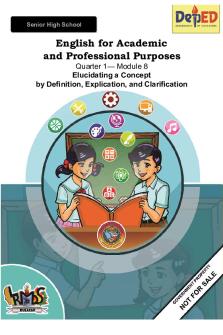
Final EAPP Q1 Module 8 - EAPP 11
- 30 Pages
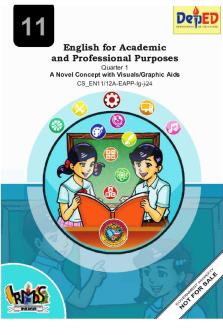
Final EAPP Q1 Module 10 - EAPP 11
- 24 Pages

CPAR Quarter 2 - Module 1 -5
- 48 Pages
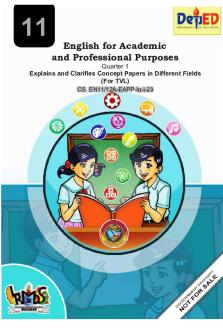
Final EAPP Q1 Module 9 - EAPP 11
- 22 Pages

Entrep Quarter 2- Module 2
- 7 Pages

EAPP Quarter-1-WEEK-1
- 19 Pages

CESC Module 6 Quarter 2
- 17 Pages
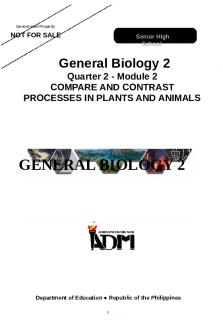
General Biology 2 Quarter 2 Module 2
- 52 Pages
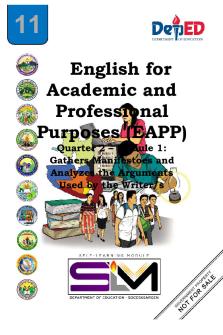
EAPP- Q2- Module 1 - english
- 22 Pages

AP Grade 9 Quarter 2 Module 2
- 24 Pages
Popular Institutions
- Tinajero National High School - Annex
- Politeknik Caltex Riau
- Yokohama City University
- SGT University
- University of Al-Qadisiyah
- Divine Word College of Vigan
- Techniek College Rotterdam
- Universidade de Santiago
- Universiti Teknologi MARA Cawangan Johor Kampus Pasir Gudang
- Poltekkes Kemenkes Yogyakarta
- Baguio City National High School
- Colegio san marcos
- preparatoria uno
- Centro de Bachillerato Tecnológico Industrial y de Servicios No. 107
- Dalian Maritime University
- Quang Trung Secondary School
- Colegio Tecnológico en Informática
- Corporación Regional de Educación Superior
- Grupo CEDVA
- Dar Al Uloom University
- Centro de Estudios Preuniversitarios de la Universidad Nacional de Ingeniería
- 上智大学
- Aakash International School, Nuna Majara
- San Felipe Neri Catholic School
- Kang Chiao International School - New Taipei City
- Misamis Occidental National High School
- Institución Educativa Escuela Normal Juan Ladrilleros
- Kolehiyo ng Pantukan
- Batanes State College
- Instituto Continental
- Sekolah Menengah Kejuruan Kesehatan Kaltara (Tarakan)
- Colegio de La Inmaculada Concepcion - Cebu
